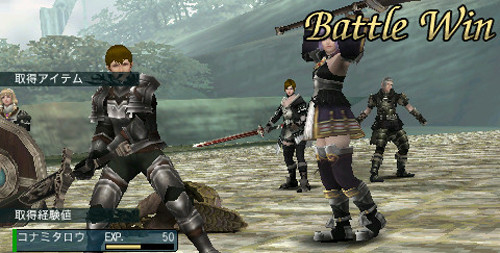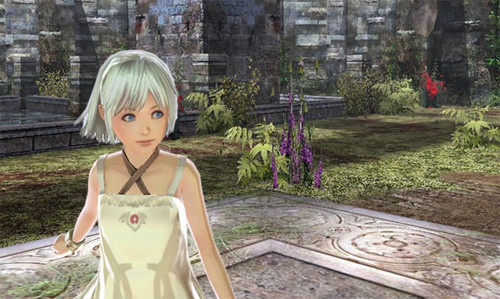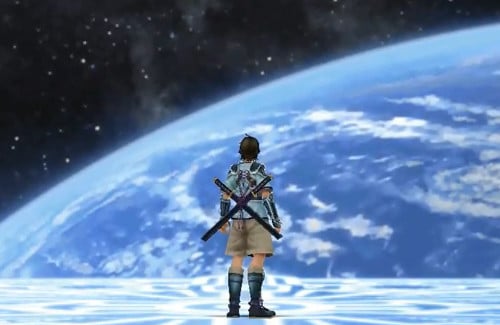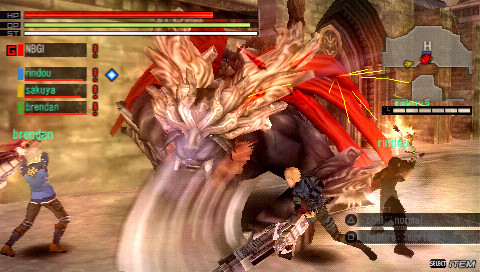The X Button
Food of the Gods
by Todd Ciolek,

We begin this week with a call to action. As RPG publisher Falcom's 30th anniversary approaches, Good Smile Company plans to turn three Falcom characters into Nendoroid Puchi toys, those huge-headed, tiny-bodied, high-quality little figures familiar to many anime fans. To decide on which trio to immortalize in Nendoroid form, Dengeki PlayStation put up a poll that asks us to choose our three favorite Falcom faces. The anime-toy industry being what it is today, all of the choices are female characters; not even Falcom's most recognizable creation, Ys franchise hero Adol, is allowed on the ballot. Nevertheless, it's an extensive chronicle of Falcom history, picking just about every major character from Ys and Legacy of the Wizard up through Vantage Master and Gurumin.
Of course, a lot of these characters never showed up in North America. Falcom is one of those companies with a large cult following in Japan and minor recognition everywhere else, so most of the games represented either stayed in Japan or lapsed into obscurity after coming West. Recent years have seen more Falcom titles translated, but I imagine that many devoted RPG nerds will look at the Nendoroid poll and wonder just who they should vote for.

Well, I'll tell them who to vote for: Popful Mail. She's the red-haired elf in the last row and also the titular star of an action-RPG. Falcom ported the side-scrolling Popful Mail to the PC Engine and Super Famicom in the 1990s, but the best version was on the Sega CD. Programmed by Sega themselves and translated by Working Designs, this form of Popful Mail is a cheerful, amusing, and wickedly hard tale that pairs the money-hungry Mail with a sedate magician named Tatt and a fire-breathing cave-dragon named Gaw. And they hunt villains called Nuts Cracker, Muttonhead, and the Schwarzenegger-esque Sven T. Uncommon. It's that sort of game.
The various incarnations of Popful Mail were well-received, even inspiring an animated trailer directed by Yuji Moriyama. Unfortunately, all attempts to branch beyond games were forgettable (a series of drama CDs even replaces Tatt and Gaw with generic fantasy heroines), and Popful Mail faded. But it always deserved better, and it certainly deserves a Nendoroid figure. So vote for Mail.

If you resent the whole idea of this poll, then I suggest you cast a vote for Umber Galsia (or is it Amber Garcia?) from Brandish, as she's the least cutesy character in the whole lineup. That'll shake the system.
NEWS
TRI-ACE UNVEILS NEW RPGS, TAKES ON OTHER GENRES
Tri-Ace spent the past few years aiming high and missing, as they put out big-budget console RPGs that seldom impressed. Resonance of Fate rose to the challenge, but Star Ocean: The Last Hope and Infinite Undiscovery are destined to be remembered only for their more embarrassing cutscenes. So tri-Ace now turns to Konami, to handhelds, and to less familiar RPG fields.

The first of tri-Ace's two new projects is Frontier Gate, the company's apparent take on multiplayer RPGs. While the words “Monster Hunter clone” were bandied around shortly after the game's announcement, Frontier Gate uses the turn-based mechanics of traditional RPGs. It still has co-op play in mind, as up to three can join up for ad-hoc gameplay using six characters, as each player controls a lead warrior and his or her partner. The game's storyline explores the wilds of a land called Frontier, and the player's avatar finds fifteen partners in adventure, with the story changing as new friendships are forged. Three were revealed this week: the swordsman Aeltio, the instructive Reinwalt, and the native guide Dizzy.

Beyond the Labyrinth is a touch more interesting: a 3DS dungeon-crawler with lush visual stylings already compared to Fumito Ueda's Ico. The only character revealed so far is a blue-haired girl in a sundress; in contrast to Ico's taciturn princess Yorda, Beyond the Labyrinth's heroine will reportedly talk quite a bit during the game. The development team, headed by Takayuki Suguro (Valkyrie Profile 2, Resonance of Fate), promises a bright atmosphere, though the preliminary screenshots show a lot of lonely ruins and overcast skies.
Neither Beyond the Labyrinth nor Frontier Gate has a specific release date, but both are expected next year under Konami's label. At any rate, it's a welcome new direction for tri-Ace. The company has long made games with good battle systems and lousy storylines, so multiplayer RPGs and dungeon-hacks play to their strengths. Of course, the exception to tri-Ace's track record is the Valkyrie Profile series, and I'd sure like to know what's happening in that department.
GRAND KNIGHTS HISTORY IS THE LATEST VANILLAWARE LOOKER
For those who appreciate a fine piece of two-dimensional game art, Vanillaware makes some of the prettiest sights in the entire industry. They're better known for action-RPGs like Odin Sphere (which I sorta hated) and Muramasa: The Demon Blade (which I didn't), with their strategy-RPG Grim Grimoire unfairly pushed to the background. Well, Vanillaware's next endeavor returns to the slower pace of RPG warfare with Grand Knights History.

Like many RPGs, the PSP-based Grand Knights History tells of a land torn apart by feuding powers. Ristya, the land in question, is caught up in a war waged by the belligerent mountain kingdom of Logres, the religion-ruled nation of Union, and the mysterious forest land of Avalon. In this tale of witch-empresses, frigid tyrants, noble knights, and exiled princesses, the player controls a customized character, while Liscia, a squire, serves as a guide throughout the game.

The game's combat is turn-based, though it demands the sort of planning one normally sees in a tactical RPG. A party's formation plays a big role in how it fares in battle, and characters develop stats in accordance with their unique personalities. And it's all really pretty, with the large characters and detailed animation Vanillaware loves so much. Grand Knights History is out in Japan come September, and it stands a good chance in North America.
CHAOS RINGS GETS TWO FOLLOW-UPS, ONE VERY SOON
Square Enix's Chaos Rings is essentially a PlayStation-era Final Fantasy for the iPhone, and a lot of people wanted exactly that. Inspired by the original game's success, Square Enix is prepping two more Chaos Rings titles: Chaos Rings Omega and Chaos Rings 2.

Omega, set to ship for the iOS platforms this very month, is set 10,000 years before the events of the original Chaos Rings. Normally this would prevent any characters from the first game from showing up in Omega, but the first trailer apparently shows Vahti, Olgar, and possibly Ayuta. The world of Chaos Rings is a tightly wound ball of alternate realities, so 10,000 years might not be such an obstacle to its storytelling. There are numerous new faces, though, and they all get character art by the underrated Yusuke Naora.
Square Enix and developer Media.Vision have shown far less of Chaos Rings 2, and it has no release date yet.
PLAYSTATION NETWORK WANTS TO BE LOVED AGAIN
For those still waiting for the PlayStation Network to recover from its hacker-wrought outage, Sony promises that the service will be back up “this week,” which we assume to be “the end of this week.” Sony's also offering a few incentives to returning PSN users: some yet-to-be-specified free downloads, along with 30-day memberships in the PlayStation Plus service and the Music Unlimited program. I suggest holding back forgiveness until they agree to make another Parappa the Rapper.
REVIEW: GODS EATER BURST
 Developer: Shift/Namco Bandai
Developer: Shift/Namco Bandai
Publisher: D3 Publisher
Platform: Sony PSP
Players: 1-4
MSRP: $39.99
Like the bizarre deities it showcases, Gods Eater Burst is a roughly assembled chimera. It's built on the same foundations as Capcom's Monster Hunter games, but Namco Bandai and Shift went beyond that franchise's drawn-out searches and multiplayer focus. They brilliantly threw in every else the Japanese market likes in its games: the glitzy modern pop-anime stylings of a Persona game, the towering, inventive beasts of a Final Fantasy, and the demolished landscape that sets in after any given science-fiction apocalypse. With all of that behind it, Gods Eater Burst is far more than a rip-off. It's a cunning and often successful attempt to best Monster Hunter at its own game.
Gods Eater Burst doesn't settle for the relaxed and natural environments of a Monster Hunter jungle. Its world is half-destroyed, a sprawl of city ruins and empty caverns, with human civilizations driven to the margins by a race of mutated creatures called Aragami. An organization called Fenrir arises in this land, equipping eager, often short-lived young hunters with weapons called God Arcs and sending them off to slay Aragami. Your character's entirely customized, but he or she is dropped in among the usual anime-RPG suspects: cocky alpha-guy Lindow, his more-than-friend Sakuya, silent grumbler Soma, boyish new recruit Kota, and the stuffy, secretly troubled foreign student Alisa. And there's a cast of mechanics, merchants, clerks, peripheral hunters, bizarre semi-humans, and vaguely ominous higher-ups to help you advance through the ranks of Fenrir. It's an average story by general game standards and a heavy one by Monster Hunter's measure, but it all just backs the Aragami-slaying at hand.

Not exactly docile wild beasts or natural predators, the Aragami are vicious things that lurk in relatively small sections of city or underground. You'll stalk them in groups, normally bringing along three other players or, in the solo mode, three computer-controlled allies. You're technically stuck with one weapon, but your God Arc is a highly versatile creation, transforming from a massive edged weapon to a multi-function cannon at the touch of a button, and it's also capable of protecting you from Aragami assaults. Switching between the two forms of attack demands some balance: pelting an enemy with shells drains your energy, which is best replenishing by switching to a bladed God Arc and slashing at things up close. This, of course, makes you more likely to be clawed at by the creature or shot by your well-meaning friends.
Gods Eater Burst makes a strong first impression by cutting a lot of fluff. You're given an extensive spread of guns, blades, and shields early in the game, and you're not forced into simple introductory missions, either. The game's hunts rarely want for action, as the smaller areas and more aggressive prey cut down on aimless searching. Fenrir's base of operations is an efficient, fast-moving machine, and the upgrading process kicks in with compelling ease. The options for customizing your God Arc are impressive, ranging from conventional weapons to arcane designs. There's also a wide range of bullets, and all of them can be tweaked and adjusted with the help of an indoor firing range. Even recovery bullets are in the armory, letting you or your allies shoot the teammates you want to heal. The options for customizing your character's appearance aren't quite as extensive as the arsenal itself, but at least you're allowed to change your hair color and 'do.

This may be a leaner game than its competitors, yet it still keeps a few unnecessary pounds. While the Aragami designs are creative, there's a lack of variety in both creatures and missions for the game's first half. The focus rarely changes from finding the target monsters and dogpiling them until they go down. Gods Eater Burst also struggles to make the most of the PSP's controls: the camera misbehaves if the center-view button isn't tapped constantly, and using items in the midst of a fight is just asking for trouble. Communicating with teammates is also something of a hassle, but at least the AI partners handle themselves well.
If Gods Eater Burst can't escape a few annoyances, it still delivers something a lot of multiplayer hunting games never approach: style. Yes, it's largely predictable anime style, but it does the trick. Between the laser barrages, the stark scenery, and the grim overtures of the soundtrack, Gods Eater Burst has a flair for the intense. You're rarely without a full team to join in the chaos of taking down an Aragami, and the game's forgiving if you're knocked unconscious. The God Arcs are exceptionally cool three-in-one weapons. Resembling anything from a chainsaw-minigun sword to a mass of hornlike cannons and telescoping rib-blades, they're equally varied in their attacks. Aerial moves are easy to pull off, particularly in a powered-up Burst Mode, and God Arcs can even sprout enormous jaws to devour enemies for new items.

It's this style, however mired in anime, that keeps Gods Eater Burst just a shade fiercer than the norm. There's a slick mess of an intro, a serviceable graphics engine, and a ridiculous, sexed-up spike to the character design. Even the story plays a part. It's thinly plotted twaddle with only one or two surprising twists, but it fulfills the window-dressing role that so many game plotlines serve. It's another piece of the world, and another little reason to push through the game's ten levels of hunts. The voicework's fairly good, though the translation presents some oddities. Despite the game's title changing slightly for North America, Fenrir's warriors are still called “god eaters” in-game, and one early exchange refers to your character as “he” even if you're playing a woman. Perhaps she was wearing too much.
Gods Eater Burst did well in Japan, but it can't catch Monster Hunter in scope, diversity, or sales. Perhaps there's hope for the series as an alternative, especially for those who found Monster Hunter too dry, too sluggish, or too nice. Gods Eater Burst doesn't beat its rival in every department, but it's an altogether more memorable game: a quick, engrossing, violent safari that seldom wastes your time.
NEXT WEEK'S RELEASES
YU-GI-OH! 5D'S WORLD CHAMPIONSHIP 2011 OVER THE NEXUS It's time once again to see how Yu-Gi-Oh! is doing, what with its popularity slightly waning and its Japanese parent companies suing 4kids over the franchise. That can't keep Konami from putting out another Yu-Gi-Oh! title, of course. Over the Nexus has 4,200 virtual cards based on the 5D's series, and players use them while sitting through the game's story mode, taking on others in Wi-Fi matches, or teaming up with three other players in the Duel Runner competition. There's also a deck-editing AI to evaluate and rebuild card collections, and dueling locations introduce different rulebooks: Crash Town duels give the first turn to the player who completes a card-tapping game, while Stadium duels settle things with a quick race. And for those who've never played Yu-Gi-Oh! before Beyond the Nexus, there's a tutorial included. Yes, this is a slow week for releases, but think on this: Konami makes money from the reliable churn of Yu-Gi-Oh! games, and some of that money funds less safe projects. So if you've enjoyed any of Konami's experiments in the past few years, from Dewy's Adventure to Time Hollow, you owe some quiet thanks to Yu-Gi-Oh! and all of its 4,200 cards. |
discuss this in the forum (17 posts) |
this article has been modified since it was originally posted; see change history
 Developer: Konami
Developer: Konami